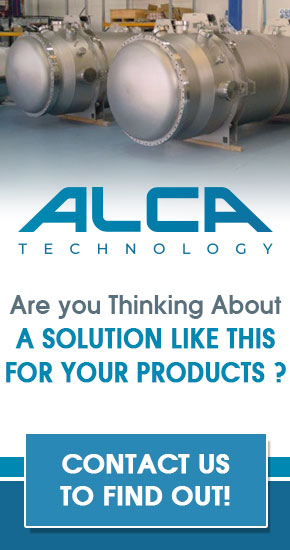The Application of Thin Films in Preventing Corrosion

Thin films are thin layers of materials with thickness usually ranging between some nanometers (10-9 m) to several micrometers (10-6 m). As a reference, a human hair has a typical thickness of 40 to 60 micrometers.
Despite their very small thickness, they are effectively used by the industry to protect metals from corrosion. This helps metal parts -and, finally, the products which are made with those parts- to last longer when exposed to adverse environmental conditions.
The process of applying thin films on the surface of raw materials and finished components is known as “thin film deposition”. As an example, a typical application of thin films is seen in the household mirrors, where a thin layer of metal deposited behind a glass plate makes it exceptionally reflective. Thin films have found usefulness also in many other common-life applications. As an example, they are used to improve the optical properties of glasses, and camera lenses; they provide wear protection and aesthetic appeal in doorknobs and handles; they provide finishing and durability to automotive parts, etc.. Moreover, the applications of thin films spans also in a wide range of industrial applications: as an example, their use in semiconductor devices, telecommunications, liquid crystal and OLED displays, audio and video systems, compact discs, solar cells, LEDs, multilayer capacitors, aerospace and military applications can be considered.
The deposition of thin films can be performed in a vacuum chamber, or using other technologies like spray coating, dip coating, galvanic deposition, etc. This topic will be covered in greater details in a further article, with particular reference to the vacuum deposition technologies.
Types of metal and their corrosion vulnerability
Corrosion is the phenomenon consisting in the loss of material, usually from the surface of a metal or alloy, resulting from the formation of oxides in the presence of particular environmental conditions like presence of moisture or elevate temperatures. A common example is the formation of rust on the surface of steel, due to the presence of water. There are many possible forms of corrosion which are well documented in the literature. They are usually classified considering both the underlying corrosion process, and the particular metal or alloy which can be potentially affected.
Here are some few examples of metals/alloys used by the industry, and the related corrosion process, which could eventually take place.
| Type of metal | Type of corrosion |
|---|---|
| Steel and stainless steel | Galvanic: normal uniform corrosion, crevice corrosion, pitting, stress corrosion cracking, corrosion fatigue, etc. Hot corrosion. |
| Aluminum alloys | Galvanic: pitting, normal uniform corrosion, interstitial corrosion, etc. |
| Copper alloys | Galvanic: uniform attack and tarnishing. |
| Brass | Galvanic: uniform attack, stress corrosion, dezincification. |
All these possible forms of corrosive damage can potentially lead to a loss in mechanical integrity and/or to aesthetic deterioration of the affected parts and products. The effects of corrosion are enormous to our daily lives. As an example, the durability of most of the kitchen utensils and appliances that are made up of metals are shortened, bridges can even collapse due to corrosion problems, leading to loss of lives and properties, thereby consequently affecting even the economy of the country, etc.. This, in turn, corresponds to a money loss that has been evaluated globally in several trillions of $ per year.
Prevention is the best way to keep metals longer upon exposition to its operative environment.
Also a further, important factor should be considered: due to the low quantity of protective material used, and to continue development of better coating deposition technologies, the use of thin films is an environmentally friendly technology to protect the materials from corrosion in a sustainable way.
The role of thin films in corrosion protection
Corrosion can take place on the surface of a metallic material if some environmental conditions are present. Wet corrosion, usually acting at low temperatures, requires the presence of water in contact with the bare metallic surface. Hot corrosion, acting at elevated temperature, requires oxygen, or other oxidizing materials, to be in contact with the metal. Therefore, one of the possible strategies to preventing, or to slowing down corrosion to an acceptable rate, is to keep, respectively, water or oxygen out of the reach of the sensitive parts.
Here is where thin films come in play about corrosion protection. Even if there are many other technologies which can be used for the same purpose (painting, use of inhibitors, active protection, etc.), the use thin films for corrosion protection is one of the more versatile, economic and effective strategies offered by the market today.
Simply said, the thin films function in this context is to provide a protective barrier for the material from its immediate environment.
To do this, the thin film must be able to resist the penetration of the liquid and/or gaseous substances cited above, which can cause corrosion, which can eventually come in contact with the exposed part. The protective thin film must be able to expand and contract with the coated metal surface without cracking, and possibly retaining its aesthetical appearance for a very long time to provide maximum protection while keeping the product pleasant. To meet these requirements, a wide range of thin film coatings, and deposition technologies have been developed, ranging from the common zinc plating process used for carpentry components, to anti-tarnish coatings used in the jewelry industry, to high-end multilayer ceramic coatings used to prevent hot corrosion in metallic parts exposed to high temperatures in gas turbines. In some application, also an organic thin film protection coating can be advised (painting): this strategy has a long and successful application story in the automotive market. Generally speaking, and regardless of the specific implementation and deposition process used, the application of thin film for preventing corrosion involves usually the use of a primer -or adhesion layer-, one or more intermediate layers, and a top coat. The material to be coated must be cleaned and pre-treated to enhance the adhesion of the other coatings after which the primer is applied to the material. The primer helps to enhance the adhesion of other coats and provides strong resistance to corrosion. The primer is the coat on which the intermediate coats will be applied. The primer must be able to protect the surface of the material for several days before the application f the top coats as it contains inhibitory substances and pigments.
The intermediate coat applied on top of the primer coat layer. The primary function of the intermediate coats is to increase the thickness of the coating system and prevent the percolation and/or the diffusion of corrosive elements from the external environment to the base material.
The final coat applied to the material is called the top coat. It is the layer that is always in contact with the external environment. Often, the top coat is required to have a well defined appearance (e.g. gloss, matt), must be strong enough to prevent wear of the underlying, protective layers, and deserve as a further barrier against infiltration of dangerous substances toward the metallic substrate.
Also other combinations of protective layers can be used depending upon the corrosive situations, and the specific protection requirements (e.g. characteristics of the environment where the part will operate, expected lifetime of the component, etc.). A simpler combination of just two layers, or even a single layer coating can be adequate in some situations. These solutions are usually easier to manufacture, and less expensive, and thus rather common.
Conclusion
The use of thin film coatings is a very significant and effective way of preventing corrosion. Their applications and influence in our daily lives are very valued, and countless. Materials need to be prevented from corrosion to increase their durability and their value, and also to safeguard lives and properties. There are many types of protective coatings based on thin-film technologies, and a wide variety of deposition processes, which will be discussed in more detail in future articles of this series.


